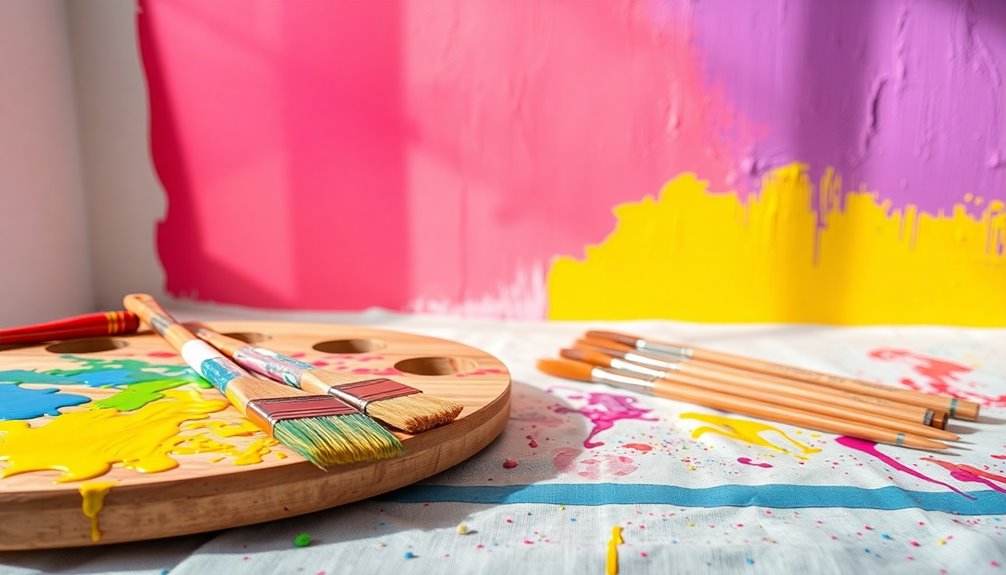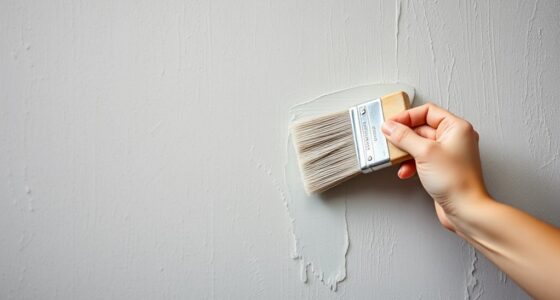To get started with wall painting, choose high-quality paint and test colors under different lighting. Remove furniture, clean the walls, and apply painter's tape for clean edges. Gather essential tools like brushes and rollers, and start painting from the ceiling down to avoid drips. Wait for the first coat to dry before adding a second coat for smoothness. Follow these tips and soon you'll learn some creative techniques to elevate your painting skills even further.
Key Takeaways
- Choose high-quality paint and appropriate sheen for your room's function to ensure durability and an appealing finish.
- Prepare your space by removing furniture, covering floors, and cleaning walls for better paint adhesion.
- Use painter's tape to mask edges and trim, ensuring clean lines and preventing paint splatters.
- Follow a systematic painting order: start with the ceiling, then walls, using rollers for large areas and brushes for edges.
- Allow paint to dry fully before moving furniture back, and clean tools properly for future use.
Understanding Paint and Color Choices

When it comes to choosing paint and colors for your walls, understanding a few key factors can make all the difference.
Start by selecting high-quality paint, which contains more pigments and additives for better coverage and durability.
Consider how different lighting affects paint color; direct sunlight will reveal true colors, while artificial light can change perceptions.
For north-facing rooms, warm colors create a cozy atmosphere, whereas cool colors work well in south-facing spaces to maintain freshness.
Don't forget about paint sheen—it impacts both appearance and durability. Higher sheens resist stains and are easier to clean.
Test paint samples on your walls in 12×12 inch squares to see how they look in various lighting throughout the day.
Preparing Your Room for Painting

Before you start painting, make sure to remove all furniture and decor from the room to create a clear workspace.
Next, inspect your walls for any cracks or imperfections, and repair them for a smooth finish.
A clean, prepared surface is essential for achieving the best results in your painting project.
Remove Furniture and Decor
Preparing your room for painting starts with removing all furniture and decor.
Begin by taking out any furniture, creating ample space for movement and preventing paint splatters on your belongings.
Next, carefully take down wall decor like pictures, mirrors, and shelves to guarantee every surface is accessible and to avoid damaging these items during the process.
Don't forget to remove outlet covers and light switch plates for a clean painting edge.
If you can't move larger items, shift them to the center of the room and cover them with plastic or blankets.
Finally, lay down drop cloths or tarps on the floor to catch spills and protect your flooring throughout the entire painting project.
Clean and Repair Walls
To achieve a flawless finish, start by inspecting your walls for any cracks, holes, or imperfections that could mar your paint job. If you spot any, fill them with spackling compound using a putty knife, then let it dry completely before sanding smooth with 220-grit sandpaper.
Next, clean walls thoroughly with an all-purpose cleaner or degreaser to remove stains and dust, ensuring a clean surface for better paint adhesion.
Don't forget to cover your floors and any remaining furniture with drop cloths to protect against paint splatters.
Finally, maintain proper ventilation by opening windows and using fans to promote airflow.
This preparation will set you up for a successful painting experience.
Essential Tools and Supplies Needed

When tackling a DIY wall painting project, having the right tools and supplies can make all the difference in achieving a professional-looking finish.
Start with high-quality paint supplies, including a paint roller and tray for even coverage on large areas. An angled paint brush is essential for cutting in around edges and trim, ensuring clean lines.
Don't forget painter's tape; it's vital for masking off areas you want to protect from paint splatters. A durable canvas drop cloth will safeguard your floors and furniture from spills.
Finally, keep a putty knife and spackling compound handy to fill in any nail holes or imperfections on the wall for a smooth surface before you begin painting.
Choosing the Right Paint Sheen

When you're picking paint for your walls, understanding the different sheens is key to achieving the look and durability you want.
Consider how each sheen type fits the specific function of your room and how much wear and tear it'll face.
Understanding Sheen Types
Choosing the right paint sheen can make a significant difference in how your walls look and function. Understanding the various types of paint sheen helps you select the best option for your needs.
| Sheen Type | Description |
|---|---|
| Flat/Matte | Non-reflective, great for ceilings; not washable |
| Eggshell | Slight luster; moderately durable for living spaces |
| Satin | Low-sheen; easy to clean; good for high-traffic areas |
| Semi-Gloss | Shiny, durable; ideal for kitchens and bathrooms |
| High Gloss | Extremely shiny; perfect for trim and moisture-prone areas |
Consider that glossier paints, like semi-gloss paint, highlight imperfections more, while flat and matte sheens provide a smooth, non-reflective finish. Choose wisely based on durability and washability!
Room Suitability Guidelines
Selecting the right paint sheen can enhance both the aesthetics and functionality of your rooms.
Understanding room suitability is key when choosing interior paint. Here's a quick guide to help you decide:
- Flat sheen: Best for ceilings; not wipeable.
- Matte sheen: Good for low-traffic areas; avoid frequent cleaning.
- Eggshell sheen: Ideal for living rooms and bedrooms; moderate durability.
- Satin sheen: Perfect for high-traffic spots like hallways; easy to clean.
- Semi-gloss and high gloss: Best for kitchens and bathrooms; withstands moisture.
Before deciding, test out paint samples to see how they look in your space.
Maintenance and Durability
While the right paint sheen can dramatically impact both the look and longevity of your walls, understanding how each finish performs is vital for maintenance.
Higher gloss levels, like semi-gloss and high gloss, offer greater durability and stain resistance, making them ideal for high-traffic areas. However, these finishes can also highlight surface imperfections, so they're best for trim or cabinets.
For living spaces, consider eggshell or satin finishes, which strike a balance between aesthetics and cleanability, suitable for areas needing some washability.
Flat and matte finishes, while visually appealing, are less durable and better suited for ceilings or low-traffic zones.
Choosing the appropriate paint sheen guarantees both maintenance and durability for your painted surfaces. Additionally, regular canvas maintenance on pop-up campers can help preserve their condition and appearance, similar to how proper paint care extends the life of your walls.
Step-by-Step Painting Process

To achieve a professional-looking paint job, follow these essential steps in the painting process:
- Prepare the room: remove furniture and cover floors with drop cloths.
- Clean walls with a damp cloth for a smooth painting surface.
- Apply painter's tape along edges and trim for clean lines.
- Use a high-quality primer to seal the walls.
- Start with the ceiling, then the walls, using a roller for larger areas and an angled paint brush for edges.
These proper steps guarantee your paint adheres well and looks great.
Remember to use a paint tray when working with rollers.
Once you're done, clean your tools immediately with soapy water to keep them in top shape for your next project.
Applying the Second Coat

Once the first coat is completely dry, you can confidently move on to applying the second coat. This usually takes about 2-4 hours, depending on your paint type and room conditions.
Use the same techniques as the first coat—start by cutting in edges, then roll the main wall area. This helps maintain a wet edge and prevents lap marks. If you've mixed multiple cans of paint, this guarantees color consistency across the wall.
After applying the second coat, reassess for any uneven areas; touch-ups may be needed. Remember to remove painter's tape while the second coat is still wet for clean, crisp lines without peeling the dried paint.
Happy painting!
Finishing Touches and Cleanup

After applying the second coat and ensuring everything looks even, it's time to focus on the finishing touches and cleanup.
Start by removing the painter's tape while the paint is still wet. This helps achieve clean edges and prevents peeling.
Next, follow these steps for effective cleanup:
- Wait 24-48 hours for the paint to fully dry.
- Clean tools with warm soapy water for latex paint or mineral spirits for oil-based paint.
- Seal remaining paint cans tightly.
- Store your paint in a cool, dry place for future use.
- Step back and appreciate your transformed space after moving furniture back.
With these steps, you'll wrap up your painting project efficiently and enjoy your beautiful new walls!
Common Mistakes to Avoid

While painting your walls can be a fun and rewarding project, it's vital to steer clear of common mistakes that could ruin your hard work. One major pitfall is failing to test paint samples under different lighting conditions—colors can look vastly different in daylight versus artificial light.
Proper preparation is key, so don't skip filling holes or sanding rough patches, as these imperfections will show, especially with darker hues. Pay attention to sheen; a flat finish in high-traffic areas can lead to tough stains.
Also, don't ignore safety—adequate ventilation and gear are important when using oil-based paints. Finally, remember to remove painter's tape while the paint is still wet to avoid peeling.
Follow these painting tips to guarantee a great outcome!
Frequently Asked Questions
How to Paint a Wall at Home Easily for Beginners?
To paint a wall at home easily, start by prepping your space—remove furniture and cover the floor.
Choose a high-quality, water-based paint and test it on the wall first.
Use painter's tape for clean edges around trim and windows.
Apply paint with an angled brush for corners and a roller for larger areas, using a W pattern for even coverage.
Let it dry before deciding if you need a second coat.
Clean your tools right away!
In What Order Should You Paint a Wall?
When you're preparing to transform your space, think of it like layering a beautiful tapestry.
Start with the ceiling, ensuring it's a clean canvas. Next, bring the walls to life, painting from corner to corner while keeping a wet edge.
Once the foundation is set, refine the trim and baseboards for precision. Finally, finish with doors and window frames, creating a harmonious flow.
Remember to let each layer dry for a flawless finish!
How to Paint an Interior Wall Step by Step?
To paint an interior wall step by step, start by prepping the room—remove furniture, clean the walls, and cover the floor.
Fill holes, sand smooth, and apply primer if needed. Choose a water-based acrylic latex paint, then use painter's tape to mask edges.
Cut in around trim with an angled brush, then roll the paint on in a W pattern.
Let it dry before checking for a second coat, removing tape while wet for clean lines.
What Is a Common Mistake When Painting With a Roller?
They say, "A stitch in time saves nine," and it's true when painting with a roller.
One common mistake you might make is overloading the roller with paint. This can lead to drips and uneven coverage, ruining your hard work.
Remember to keep a wet edge as you roll, and choose the right roller cover for your wall texture.
Proper surface preparation and accurate tape application will also help avoid messy results.
Conclusion
Now that you're equipped with these DIY wall painting ideas, it's time to transform your space! Just like a blank canvas waiting for a masterpiece, your walls are full of potential. Remember to take your time, enjoy the process, and don't stress if things don't go perfectly. With practice, you'll gain confidence and skill, turning your home into a reflection of your unique style. So grab those brushes and let your creativity flow!









